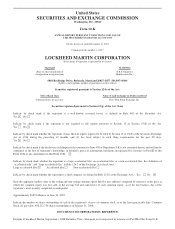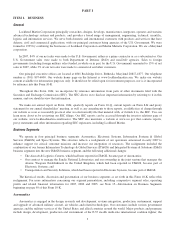Lockheed Martin 2007 Annual Report Download - page 18
Download and view the complete annual report
Please find page 18 of the 2007 Lockheed Martin annual report below. You can navigate through the pages in the report by either clicking on the pages listed below, or by using the keyword search tool below to find specific information within the annual report.trials to be held in Spring 2008. A second ship with a different design (LCS-2) is being built by a competitor. In 2007, work
on the next two ships in the program (LCS-3, under contract to us, and LCS-4, under contract to our competitor) was
terminated by the U.S. Navy. A competition to build the next ship in the program is expected to be held in 2008, with
additional phases of the program to follow.
We were awarded a contract by the Portuguese Ministry of Defense to provide a full mission system avionics upgrade
on five P-3C maritime surveillance aircraft. The upgrades include electronic support measures, acoustics, communications,
electro-optic and infrared systems as well as new data management software and hardware including controls, displays and
mission computers. Delivery of the first upgraded aircraft is scheduled for late 2009.
Missiles & Fire Control
Missiles & Fire Control develops and produces land-based, air, and theater missile defense systems, tactical battlefield
missiles, electro-optical systems, fire control and sensor systems, and precision-guided weapons and munitions.
The PAC-3 missile is an advanced defensive missile designed to intercept incoming airborne threats. During 2007, we
delivered a total of 176 missiles, with deliveries to Japan and the Netherlands representing the first international PAC-3
deliveries. We were awarded a sixth production contract in December 2007 for 148 PAC-3 missiles including 108 U.S.
missiles and 40 missiles for international customers.
The Terminal High Altitude Area Defense (THAAD) system is a transportable defensive missile system designed to
engage targets both inside and outside of the Earth’s atmosphere. The THAAD system is comprised of the THAAD fire
control and communication units, missiles, radars, launchers and ground support equipment. The program, currently in the
development phase, conducted four successful test flights in 2007 and has conducted eight successful flights overall.
Progress continued on a production contract with the MDA, received in late 2006, for two fire control and communications
units.
The Arrowhead fire control system provides modernized targeting and piloting capabilities for Apache helicopter crews
to the U.S. Army and international customers, continuing our over 20-year legacy of providing pilot night-vision sensors and
targeting capabilities for the Apache. More than 1,000 sensor systems have been delivered to the U.S. Army and foreign
military customers since 1983. The Arrowhead kits will replace certain legacy hardware on the U.S. Army and other
international customers’ Apache helicopters to provide a modernized sensor for safer flight in day, night and bad weather
missions and improved weapons targeting capability. The initial Arrowhead production contract was awarded in 2003. Major
new awards were received in 2007 for Arrowhead Lot 4, which authorized the production of 158 Arrowhead kits through
December 2009 for the U.S. Army and international customers. A four-year performance-based logistics contract was also
awarded in 2007.
Missiles & Fire Control received a number of new contracts and follow-on orders and achieved key program milestones
in 2007. Significant orders included awards for several tactical missile and fire control programs from various international
customers. In October, we delivered our 20,000th Hellfire missile. In addition, we lead a multinational venture that is
developing the Medium Extended Air Defense System (MEADS), a mobile air defense system designed to replace Patriot
systems used by the United States and Germany, and Nike Hercules systems in Italy. The MEADS program successfully
completed the component preliminary design reviews. Product sustainment and logistic services continue to be a major focus
for growth opportunities, resulting in significant orders in support of fire control and tactical missile programs.
Platform, Training & Energy
Our Platform, Training & Energy (PT&E) business integrates mission-specific applications for fixed and rotary-wing
platforms, including providing logistics and sustainment; develops and integrates postal automation and material handling
systems; develops tactical wheeled vehicles; and provides simulation, training and support services. We also manage Sandia
National Laboratories in the U.S. for the Department of Energy. Sandia National Laboratories supports the stewardship of the
U.S. nuclear weapons stockpile, developing sophisticated research and technology in the areas of engineering sciences,
materials and processes, pulsed power, microelectronics and photonics, micro-robotics, and computational and information
sciences. In the United Kingdom, we own one-third of a joint venture that manages the Atomic Weapons Establishment
program.
We lead an industry team to provide the new fleet of “Marine One” helicopters for the President of the United States.
VH-71 is the Presidential Helicopter replacement program, and is planned to provide a command and control capability to
enable the President to perform the full duties of the office while airborne. We are currently performing on Increment 1,
10
























